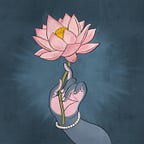An account of Bhūta Kola
17th/18th c., Karnataka
Pilichamundi is a name composed of “Pilli” (Tiger in Tulu language) and “Chamundi”, a ferocious form of the Hindu Divine Mother. The tiger’s significance is said to be as a protector of cattle and crops sent to earth by Shiva. It is being ridden by a figure holding a knife in the right hand and a shield in the left.
This image is from Castes and Tribes of South India, of a Būta Kola dancer belonging the Parava caste, circa 1909, by Edgar Thurston, who described būta worship as “devil dances” and a būta as a “demon”. Thurston’s description makes explicit the general view of the colonial era administrators and missionaries, a view based in Christian misconceptions about animism.
Būta (Tulu for ‘spirit’, ‘deity’; in turn derived from Sanskrit भूत meaning ‘spirit’) and kōla (Tulu for ‘play, performance, festival’). The 2000-yr old ritual involves music, dance, recital, and elaborate costumes. Recitals in Old Tulu recount the origins of the deity and tell the story of how it came to the present location. These epics are known as pāḍdanas. Būtas are deities and spirits worshipped widely in South Kanara, the coastal areas of Karnataka. They are generally considered deities, such as apotheosized local heroes or heroines or the spirits of wild animals dwelling in forests. The būtas are closely related to and also embody the wild, dangerous, and fertile aspects of divine power.
The būta kola or daiva nēma is mainly constituted of spirit possession, oracles, and the interactions between the devotees and the būtas incarnated in the impersonators belonging to the Nalike, Parava, and Pambada castes. Priest-mediums called pātri or māni of the Billava caste and mukkāldi of the Bant caste conduct the ritual. The patrons are often local landlords. The rituals and deities of involved in Būta worship were absorbed and accepted into the Hindu pantheon as Shiva and Shakti worship hundreds of years ago, a fine instance of syncretism between “sanskritic” Hinduism and local customs and practices.
Two-piece cast bronze depicting a hero of the Bhuta cult on Panjurli, the boar spirit.
In Tulu Nadu, hordes of boars often invaded and destroyed the cultivated lands so the farmers started worshipping and giving offerings to Panjurli, the spirit in the form of a boar, thinking that this would appease his mood and thus keep the wild animals away from their fields.
This belief was later on absorbed by Hinduism through the following story:
Goddess Pārvati kept a boar as a pet in her garden on Mount Kailaśa. Unfortunately this animal was unruly and destroyed things. One day, Shiva became so furious that he killed the animal. Goddess Pārvati was upset and, in order to make her forgive him, Shiva brought it back to life and transformed it into a spirit that he sent to earth with the mission to protecting righteousness and truth.
Asian Art Museum
Pilichamundi is a name composed of “Pili” (tiger in Tulu language) and “Chamundi”, a ferocious form of the Hindu Divine Mother.
As for Panjurli, the totemic origin of this bhuta is very probable as the jungles of Karnataka hosted a big population of tigers which used to feed themselves with the neighbouring cattle.
The incorporation of Pilichamundi into the Hindu Pantheon was through its incorporation into this legend:
A couple of birds got married under the benediction of Shiva and Parvati. One day, when the male bird was in danger, the female bird made the vow that she would give one of her eggs to Shiva and Parvati if they would save her husband. When the male bird got back to his wife, the egg which was meant to be given to the divine couple fell on the ground, and out of it appeared a baby tiger. Parvati raised the wild animal and taught it how to take care of her cattle on Mount Kailash. However, the tiger could not help killing a cow everyday, thinking that its blood, because of its bright red colour, would taste as sweet as cherry mixed with water. Shiva was furious when the tiger killed his favourite cow whose milk he drank and decided to send the feline to earth, in the form of a spirit which would look after cattle and crops.
Resources: Report on Bhuta Cult in South Canara District P. Padmanabha http://lsi.gov.in:8081/jspui/bitstream/123456789/6124/1/42714_1971_BHU.pdf
______________________________________________________________
If you find value in my work, I hope you consider becoming a patron or making a contribution to hindu.aesthetic@okicici. Hindu Aesthetic requires a lot of time and effort and your support would mean that I can continue bringing you the best possible content. ❤
